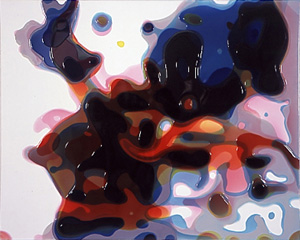December 12, 2003
Peter Zimmermann

Angstrom gallery featured Peter Zimmermann, and artist from Cologne Germany in an opening and a talk/slide show at the local MAC Center here in Dallas this week.
Going to both events is important in understanding his work. Peter's work straddles two worlds: first, his history that responds to the late 80's, early 90's art theory ("everything is a text") and secondly, the work he is doing now which is presented and "read" as the visualverse of painting. The former is a history I share with him (I came out of grad school in '91). I differ in that I took the Oedipal turn and rejected... or better, as Lawrence Wiener once put it: "...questioned the answers that were given to us in school...". The latter is is a present I share with him, something I prefer to regard as an optical intelligence, or as the unfriendly critics might put it, the problem of eye candy. This was the place his audience seemed to pivot in his presentation the other night. Some questioned the significance of the theory he footnotes in his work. Others commented in ways that implied the work was nothing but visualiciousness.
His paintings are abstracted from source material culled from his oeuvre or what he called images relevant to the art world. He processes these images in the computer and degrades the representation until he arrives at a pleasing image. His early work involved paintings of book covers, texts favored by the artworld intelligencia. They were painted using the same colored resin he uses today, and today, he paints in a manner conforming to the outlines of schema that he did back then.
This is the best proof of continuity in his work, despite the appearance of the abandonment of books for eye candy. He painted books, poster, billboards, installations mimicing commercial storefronts, everytime allowing the visuality to be distorted by circumstances of presentation and mechanical reproduction. In a signal event, a computer rendition of a poster project went awry, scrambling the images he intended into an unregnizeable but gorgeous abstraction. He accepted the serendipty of the moment and never looked back.
Note here, the use of the computer as the equal to a sketch pencil. Note too, the use of this new tool not to describe reality as, say, Picasso did in drawing a still life, but to rough up the recieved description of reality culled from the camera. This is the best way to plot his relation to Richter, whose paintings are subordinated to the camera as well. Indeed, some in his audience at the MAC called out Herr Richter's name. I would say that Peter's work differs in that his paintings are not subordinated to the camera as severely as Richter's, but I guess as long as they are derived from mechanical reproduction, they would be secondary to it. (It is interesting to me that some in our generation has wholly accepted the mediation of visuality by camera optics. A famous monochrome painter asked me why anyone would want to paint representationally. My response: the optics of the camera is not the same as the optics of the eye/brain.) Peter also asked for his work to be understood within the wholeness of a lifetime of production, his future oeuvre... something very similar to Richter's famous catalogue raisonn?. Oh, Oedipus.
There's a lot of glossy, industrial paint in our painting world for more than a decade now, so Peter's work is subject to dismissal by the cruel or careless. But his paintings are vivid and commanding while betraying no effort, not an easy feat. I've used the words "eye candy" twice, and to be sure, Peter's resin material looks every bit as delicious as candy. (He spoke intelligently, so he must be using the proper breathing masks so the fumes won't corrode his brain.) The work is ravishing and the conceptualized preparations give the visual forms he deploys a matrix so that not just anything is possible... and therefore all that you see, even the stuff that flicks your pleasure responses, are necessary and compelling. Occam's razor is still at work here. Good stuff.
Posted by Dennis at December 12, 2003 9:53 AM
Leave a comment